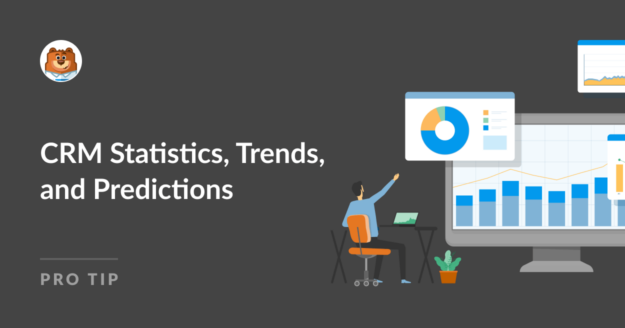AI Summary
Are you looking for up-to-date CRM statistics so you can identify trends and make more informed decisions for your business this year?
Good Customer Relationship Management (CRM) can reduce the sales cycle and improve productivity. It’s often one of the main factors behind the growth of successful businesses.
In this post, we’ll look at some key CRM statistics that reveal the increasingly important role that CRM is likely to play in the years to come.
CRM Statistics for 2024
CRM is on an explosive growth trend. Despite the disruptions to the global economy in recent years, CRM has continued to see increasing demand across a variety of sectors in the industry.
Let’s take a look at the different ways the customer relationship management industry is growing and providing benefits to organizations.
In This Article
General CRM Statistics
First, let’s look at the broad picture. CRM is showing every sign of continued growth. The forecasts suggest increasing market size and significantly higher ROI.
Whether you’re looking for the best CRM software for your business or CRM best practices to get the most out of your chosen platform, you can use the following statistics to guide your decisions.
1. The CRM Software market size is expected to exceed $88 billion in 2024. Revenue is expected to show an annual growth rate (CAGR) between 2024 and 2028 of 10.59%, projecting a 2028 market value of US$131.90 billion. (Statista)
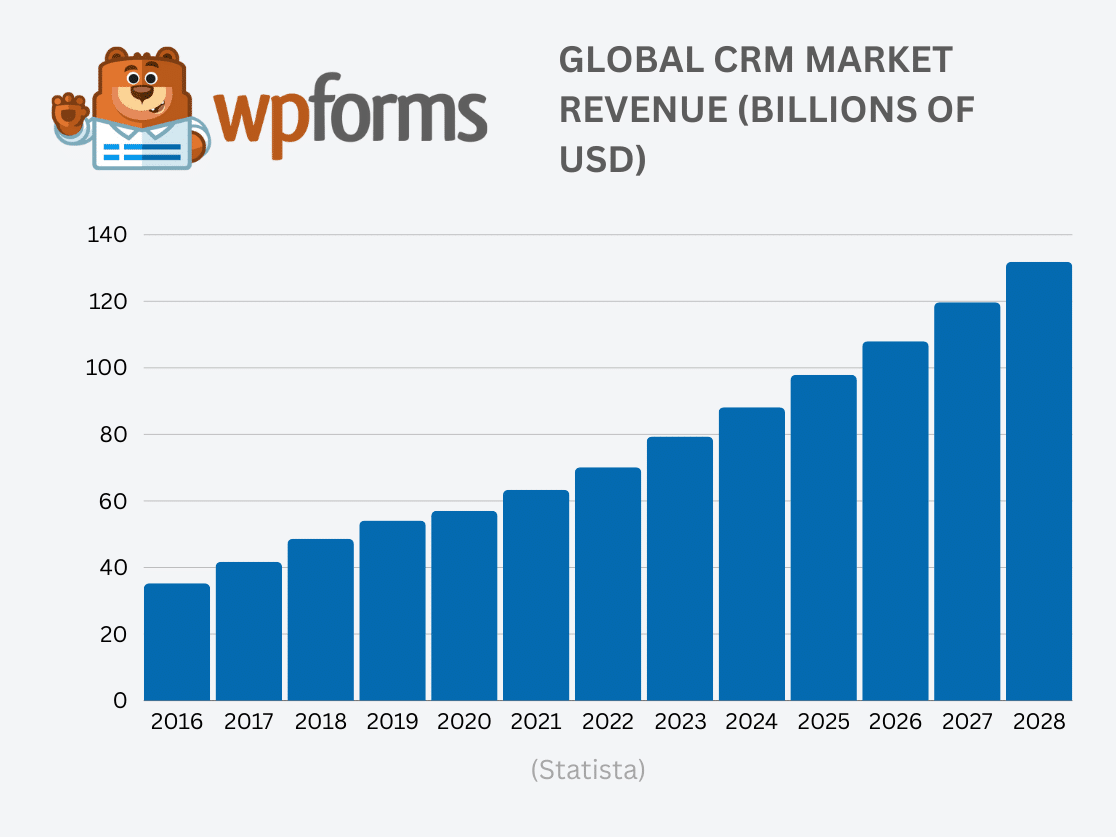
2. As IoT (Internet of Things) devices are expected to increase to over 41 billion by 2027, the opportunities for CRM system integrations with IoT feeds will also skyrocket. (Business Insider)
3. 91% of businesses with 10 or more employees use a CRM. (SuperOffice)
4. The ROI of CRM in 2023 was $30.48 for every dollar spent. (Pipeline)
5. 77% of sales professionals say their organization plans to invest more in sales intelligence tools such as CRMs. (LinkedIn)
6. According to G2 users, the average time to positive return on investment for implementing a CRM software is 13 months. (G2)
7. Most companies invest in CRM technology during the first 5 years of launch. (Capterra)
8. Salesforce, Adobe, Microsoft, Oracle, and SAP hold the highest CRM market shares, with Salesforce dominating the industry with a 23.8% market share in 2021. (Statista)
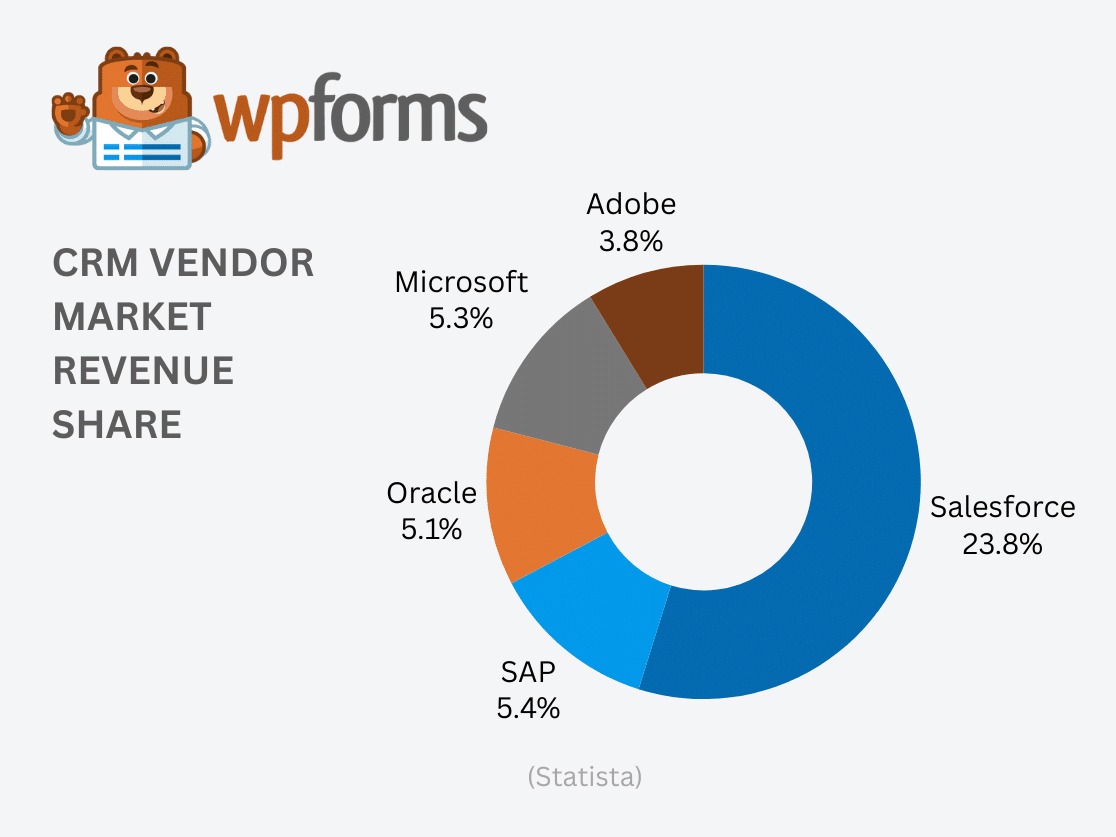
9. 72% of company revenue comes from existing customers, with 28% coming from new customers. (Hubspot)
10. 64% of B2B sales professionals offer self-service tools to help guide buyers’ purchase decisions. 85% of them say it’s an effective strategy. (Hubspot)
11. The customer service segment dominated the CRM market in 2022, accounting for a revenue share of 23.7%. The CRM analytics segment is anticipated to grow at a significant CAGR of 13.7% from 2022 to 2030. (Grand View Research)
12. Retail accounted for a CRM market share of 23.5% in 2022. An increase in online shopping and mobile shopping apps means retail companies are shifting towards CRM software and solutions to manage the growing amount of customer data, spot trends, and provide a better customer experience. (Grand View Research)
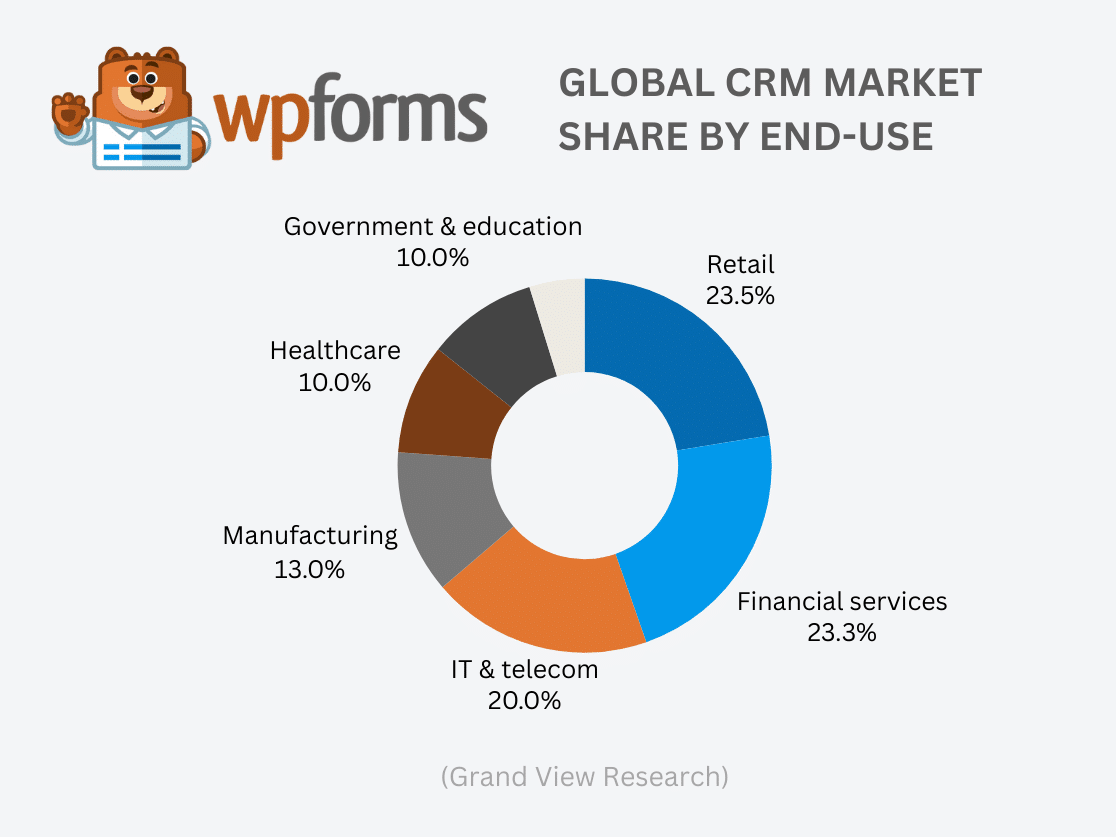
13. About 82% of companies use CRM for process automation and sales reporting. (Grandview Research)
14. 75% of business leaders claim that the COVID-19 pandemic pushed them to make more investments in digital tools for customer management. (Zendesk)
15. 92% of organizations think that technology like modern CRM systems is imperative for promoting customer-centric service. (SuperOffice)
16, 66% of companies are planning to increase their IT budget in 2024, allowing for better CRM adoption. This trend is likely to continue moving forward. (Spiceworks)
17. A third of SMEs are considering investing in a CRM within the next 6 months (Workbooks)
18. 70% of consumers say they expect conversational experiences. In larger companies with a lot of customers, this is often only possible with the assistance of a CRM platform. (Zendesk)
19. 93% of organizations recognize the importance of personalization in customer care. (Dynamic Yield)
20. 88% of sales professionals say ensuring more accurate customer data is their top priority (Veeva)
21. 92% of sales reps say that quality customer reference data is key for CRM adoption. (Veeva)
Recent CRM Adoption and Usage Trends
Although companies have historically faced challenges when it comes to adopting CRM within their teams, CRM usage is higher today than ever before and shows a rising trend.
Cloud-based CRM solutions have overtaken the market almost completely within a single decade. Like most other technology-driven fields, CRM is an area of rapid change.
1. The main reason buyers switch CRM systems is inefficiency (30%) with lack of functionality and difficulty of use also being commonly cited reasons. (Capterra)
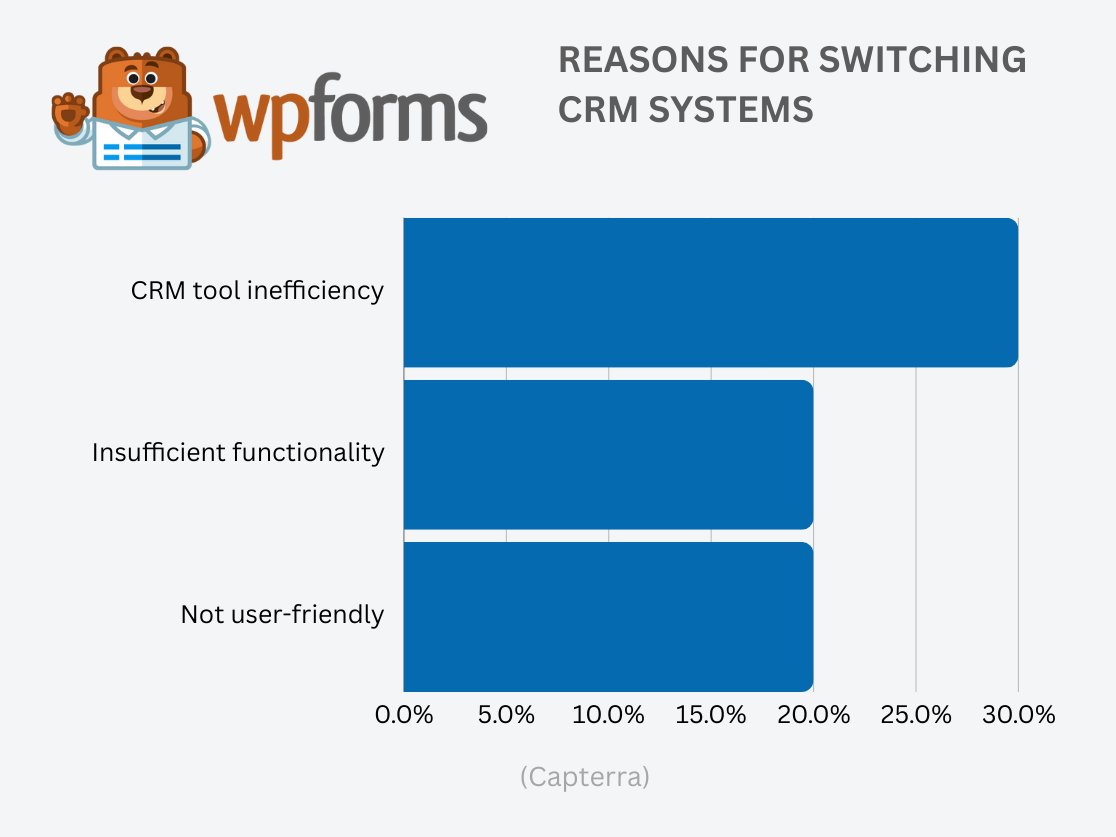
2. The average budget for purchasing CRM software ranges from $63 to $94 per user, per month. Budgets are highest for the mortgage industry and lowest for consulting. (Capterra)
3. 98% of buyers want sales automation features in their CRM and 51% say contact management is the most critical feature. (Capterra)
4. Features and functions are the most important factors when choosing a CRM for 62% of SMEs. Deployment option (cloud-based/on-premises) is also critical for 28% of organizations and 45% cite the cost of user licenses. 48% say integration with other business applications is important. 36% make their choice depending on the cost of implementation. (Workbooks)
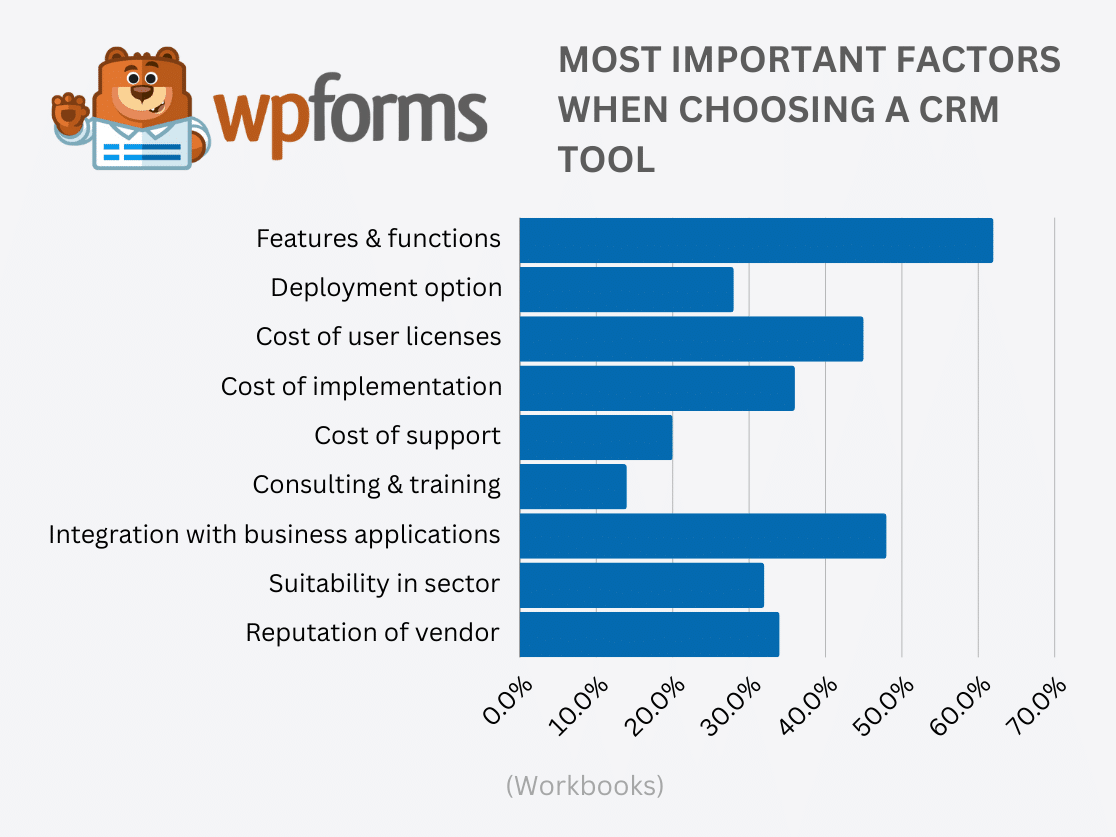
5. 87% of CRM users assert that it has helped boost sales for their company. (SuperOffice)
6. 52% of SMEs adopted CRM to improve data management and gain business insight. (Workbooks)
7. Large enterprises make up most of the customer base of CRM platforms, accounting for over 61% of the market share in 2022. (Grand View Research)
8. 28% of millennials believe CRM software is critical to their success compared to 18% of Generation X and only 9% of Baby Boomers. (99Firms)
9. 82% of sales professionals say building relationships and connecting with people is the most important part of selling and the most enjoyable part of their job. (Hubspot)
10. North America is the region with the highest adoption and accounts for about 44% of the global market. (CRM Search)
Benefits of CRM Technology & Processes
CRM has advantages to organizations in multiple industries, in a variety of ways. The statistics below sum up the results of various surveys and research highlighting how CRM is helping companies achieve their customer service goals.
1. CRM systems have been shown to increase customer retention rates by 27% and improve customer relationships in 74% of businesses. (Five CRM)
2. Implementing a CRM can increase company sales by up to 29% and increase sales productivity by as much as 34%. (Salesforce)
3. CRM provides more streamlined access to customer data, according to 72% of brands. (resco.net)
4. CRM software can improve the accuracy of sales forecasting by 32% and enhance sales productivity by 39%. (Salesforce)
5. 79% of businesses say offering live chat has had a positive effect on sales, revenue, and customer loyalty. (Kayako)
6. CRM software can reduce the sales cycle by up to 8-14%. (Pipeline)
7. 83% of business leaders reported that CRM software was either very effective or moderately effective at helping them achieve their marketing goals, more than any other type of software. (Capterra)
8. 47% of users stated that CRM significantly impacted customer retention. 47% of users also cited a significant impact on customer satisfaction. (Freshsales)
9. CRM helps sales agents keep track of service history for their customers. According to Salesforce, 68% of customers think it’s important for agents to be aware of their service history. (Salesforce)
10. The superpowers most sales professionals wish they had are predicting the future (30%), having a perfect memory (19%), and having super focus (16%) – all of which a good CRM can assist with. (Oracle)
11. 86% of sellers are frustrated by certain elements of their jobs such as doing repetitive administrative tasks that could be automated and updating multiple systems that ought to be connected. Many of these tasks can be automated with a CRM. (Oracle)
12. About 97% of sales professionals believe sales technology and CRM systems to be either important or very important for business. (LinkedIn)
13. 52% of customers will readily purchase from brands providing a better customer experience even if they have to spend more. (Zendesk)
14. 47% of CRM users believe that using CRM technology has helped improve customer satisfaction and retention. (Capterra)
The Biggest Challenges in Sales and CRM
In the world of sales, businesses encounter a range of challenges. These hurdles can significantly impact the efficiency and effectiveness of CRM systems. Each of these challenges poses unique difficulties for organizations, requiring careful consideration and strategic planning.
Conversely, businesses not using a CRM system can often overcome many of their sales challenges by implementing one.
1. 54% of sales professionals say selling was harder this year than it was the previous year. (Hubspot)
2. 28% of sales professionals say the sales process taking too long is the biggest reason prospects back out of deals. (Hubspot)
3. 42% of SMEs say users’ resistance to change is the main obstacle to successfully implementing a CRM. Availability of resources to learn how to use the CRM platform alongside their usual job tasks is another issue cited by 38%. Complexity and quality of the data (35%), and lack of IT skills among staff (32%) are other common challenges. (Workbooks)
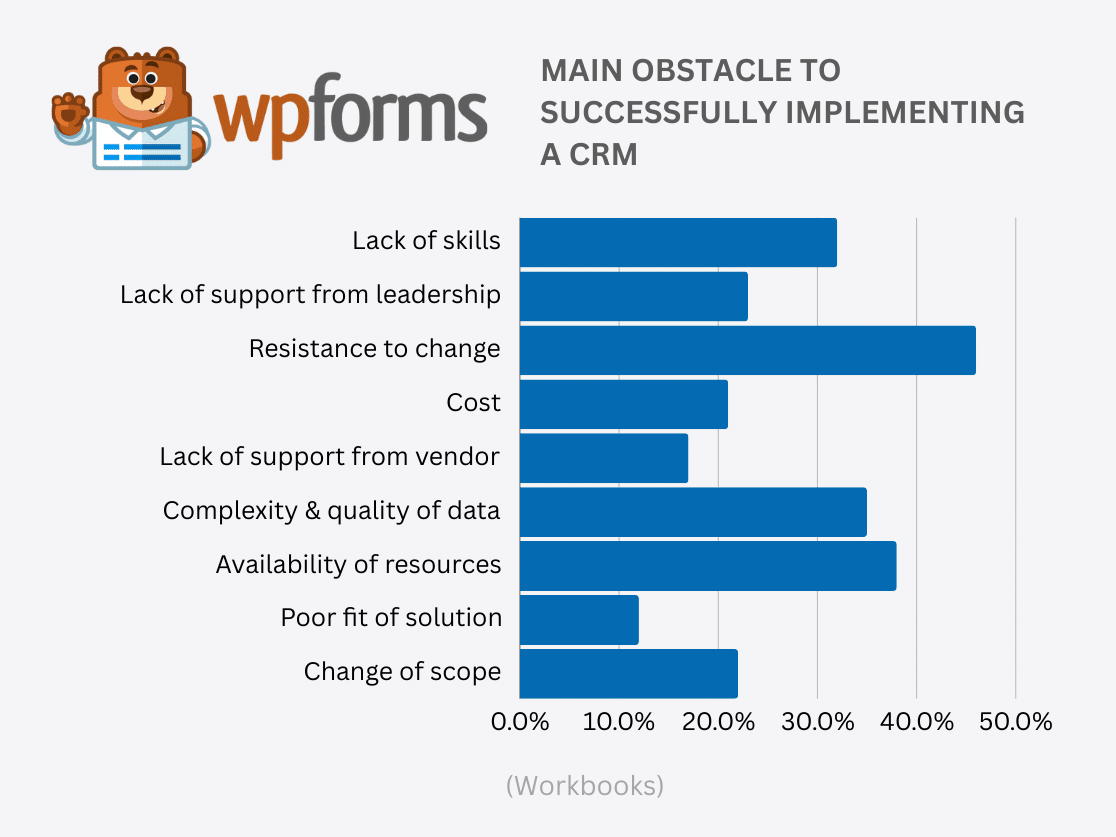
4. Privacy remains a measure concern as 46% of consumers think they don’t have adequate control over their data. An increased focus on compliance with privacy regulations like GDPR is likely to be seen in the CRM industry. (Cisco)
5. 85% of sellers admit having made potentially embarrassing mistakes due to faulty CRM data. (Oracle)
6. 66% of sellers believe their CRM is important to getting the job done, but less than half use it daily. (Oracle)
7. 42% of sellers say they have been ghosted by prospects because the competition got them first with a better offer. (Oracle)
8. 72% of sellers need to have at least three screens or windows open at once to coordinate a sales process. (Oracle)
9. 45% of businesses still use general-purpose software, such as Outlook and Excel, to manage customer interactions rather than a dedicated CRM. (Capterra)
CRM Forecast & Predictions for the Future
As the technological capabilities of CRM software advance, we can only expect it to play an increasingly vital role for organizations all over the world. The statistics below predict continued growth as well as some emerging trends directing the future of CRM.
Voice-Assisted Technology in CRM Statistics
With a growing reliance on voice-activated devices and AI-powered virtual assistants, businesses are integrating voice technology into their CRM systems. As this technology continues to evolve, it is expected to play a pivotal role in shaping the future of customer relationship management.
1. 45% of smartphone owners leverage voice activation technology in their daily lives. (SutiSoft)
2. The global voice and speech recognition market size was valued at USD 17.17 billion in 2022 and is anticipated to grow at a compound annual growth rate (CAGR) of 14.9% from 2023 to 2030. Voice technology has a wide range of applications in CRM (voice analytics, voice automation, voice search, and voice interaction) and it’s likely more CRMs will integrate voice technology to improve efficiency and enhance the customer experience. (Grand View Research)
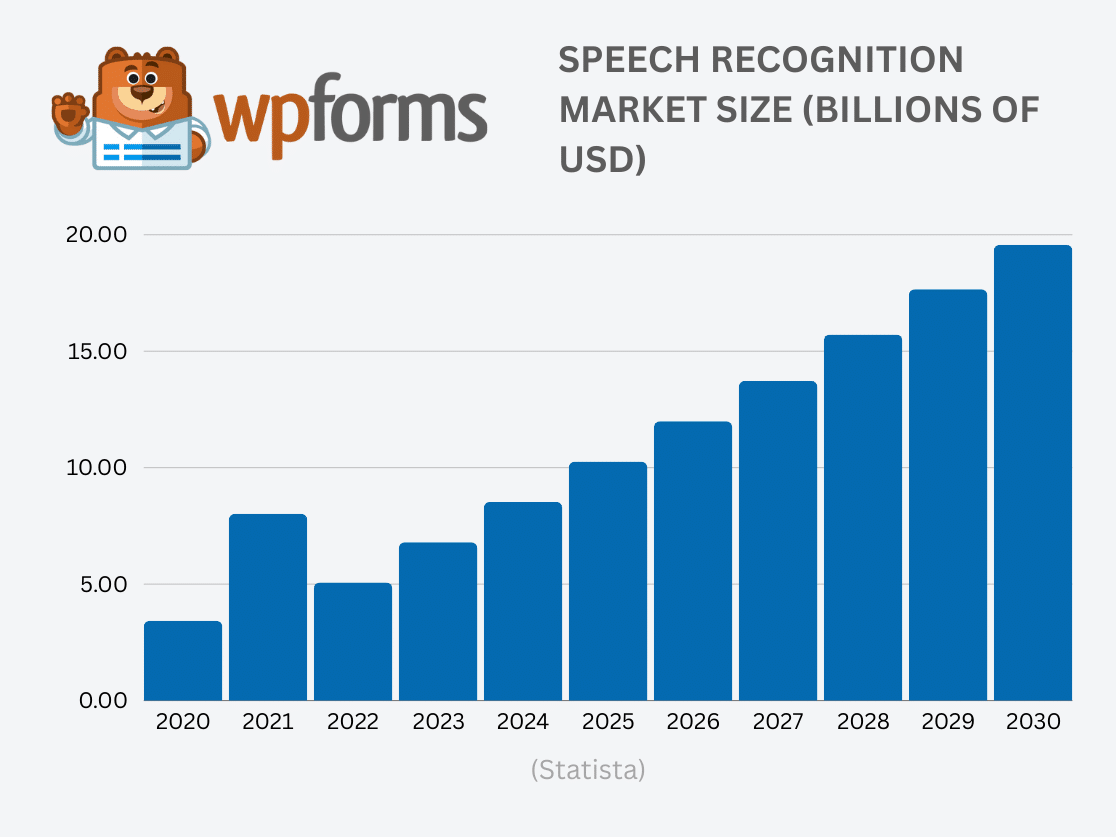
3.77% of CEOs believe that voice recognition when interacting with CRMs provides control over the brand and customer experience. (SoundHound)
4. 71% of brands believe voice technology improves the customer experience. (Adobe)
5. Voice to CRM accuracy has improved over the years, from 19% error in 2019 to 12% in 2021. (Martech Zone)
6. When working with CRM, speech recognition can accommodate 150 to 170 words per minute, which is nearly three times faster than typing on a handheld device. (SutiSoft)
7. Voice to CRM systems are able to interpret voice recordings and complete 95% of CRM fields accurately. (HeyDAN)
AI-powered CRM Statistics
With capabilities like predictive analytics, personalized communication, and automated customer service, these AI-powered CRM systems offer unprecedented insights and efficiency. As AI technology continues to advance at a rapid pace, we can expect a more personalized, efficient, and data-driven approach to managing customer interactions in the near future.
1. The integration of AI (artificial intelligence) and automation with CRM was predicted to help grow revenues by $1.1 trillion by 2021. (Salesforce)
2. 86% of IT leaders expect generative AI to soon play a prominent role at their organizations. (Salesforce)
3. 78% of organizations use AI-driven CRM solutions. (Salesforce)
4. Sales professionals who use AI tools such as an AI-powered CRM to accomplish administrative tasks save two hours a day. (Hubspot)
5. 55% of businesses use AI in the digital customer experience and 15% more organizations are planning to increase their spending on AI and machine learning in 2024 than in 2023. (CMSWire)
6. By 2025, AI-powered customer service platforms will boost efficiency by 25%. (Zipdo)
7. In the future, AI could automate more than 50% of CRM functionalities. (Zipdo)
8. Over 79% of CRM users find AI in sales tools important. (DDI Development)
9. 30% of outgoing messages from large organizations will be AI-generated by 2025. (DDI Development)
10. 61% of sales professionals believe generative AI will help them better serve their customers and 63% believe it will help them serve customers faster. (Salesforce)
11. 71% of customer-facing teams that are currently using AI use it to automate personalized sales communications. (Salesforce)
12. An estimated additional 394 billion U.S. dollars could be gained in the CRM sector in the United States through the adoption of AI. (Statista)
Mobile CRM Statistics
The surge in mobile technology has significantly impacted the CRM industry, leading to the emergence of mobile CRM as a vital tool for businesses. These statistics shed light on adoption rates, efficiency improvements, and how mobile CRM is reshaping the landscape of customer engagement in an increasingly mobile-centric world.
1. 50% of teams improve their productivity by using mobile CRM. (Forester)
2. Mobile and cloud-based CRM systems give sellers the freedom to make sales outside the office. 50% of sellers have taken sales calls on vacation. Other common locations for selling include at the dinner table (40%) and at a party or social event (33%). (Oracle)
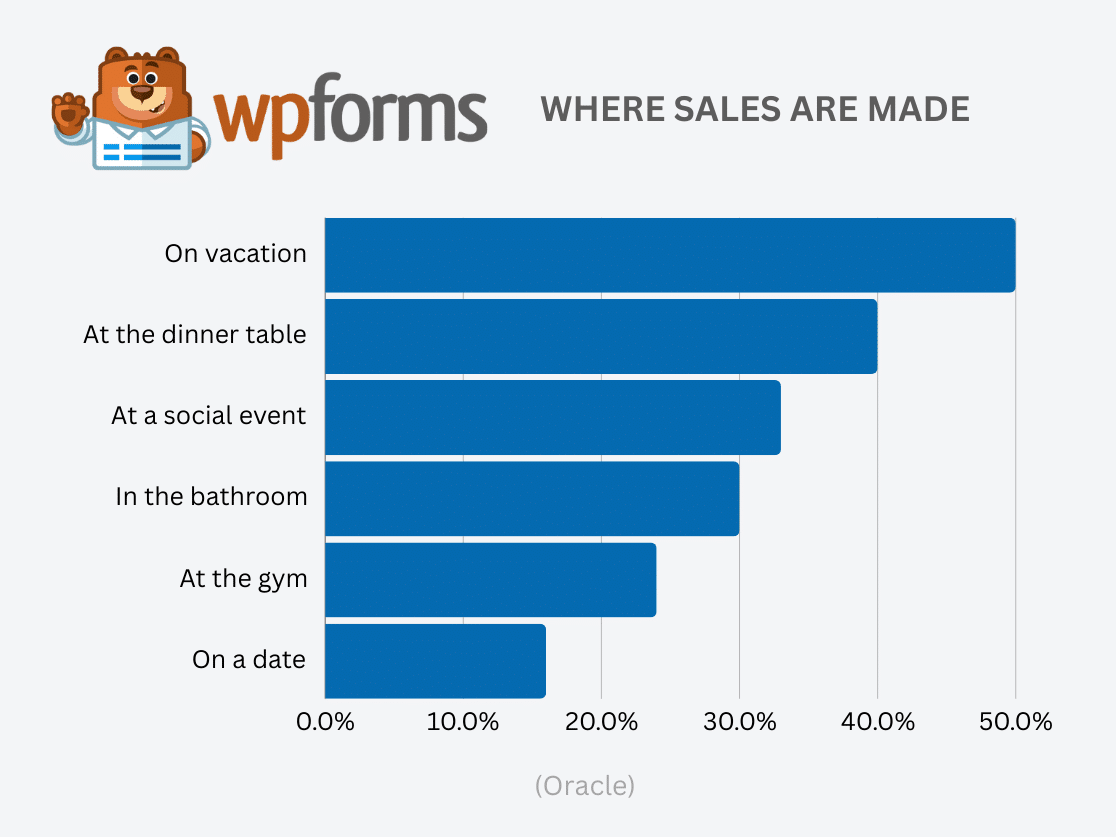
3. The top requirements for mobile CRM systems are seamless data sync across all devices (38%), an easy-to-use native app, and offline access. (Resco)
4. 53% of the salespeople say that by being able to access their CRM system on their tablet or smartphone, they noticed a significant improvement in the quality of CRM data. Other benefits mentioned include increased efficiency (50%) and faster, more informed decision-making (42%). (Resco)
5. Organizations that rely on CRM claim to have observed a 14.6% increase in productivity with the use of mobile and social CRM. (Nucleus Research)
Social CRM Statistics
The statistics in this section emphasize the importance of integrating social media data into CRM systems for a deeper understanding of customer preferences and behavior.
1. 96% of business leaders anticipate integrating social data into their company’s CRM within the next three years. (Sprout Social)
2. 88% of business leaders that agree social media management software is a critical tool in their company’s technology solutions. (Sprout Social)
3. 31% of consumers say they have increased their use of social media compared to last year in order to interact with brands and companies. (Marketing Charts)
4. 4.7 billion people globally are regularly active on social media platforms (Hootsuite)
5. Companies that increase their social media output by 10% see a 7% increase in brand awareness and a 4% increase in customer satisfaction. (Hootsuite)
6. Telecoms provider BT says 40% of its customer feedback originates on Twitter. (Salesforce)
7. 55% of Social CRM users reported increased customer loyalty and 54% increased sales revenues. (Salesforce)
8. By tracking and managing customer contacts across social media channels and business functions, customer service teams can deliver dramatically better service. 79% of Salesforce customers reported improved customer service and 63% increased customer retention. (Salesforce)
9. 91% of business leaders agree that social data positively impacts their understanding of customers. (Sprout Social)
Approaching 100% Cloud-Based CRM Adoption
The CRM landscape is witnessing a remarkable shift towards cloud-based solutions, approaching near-total adoption. This trend highlights a significant move away from traditional, on-premises systems to more flexible, accessible, and cost-effective cloud platforms.
1. Cloud-based CRM usage has increased from only 15% in 2010 to 87% in 2020. (SuperOffice)
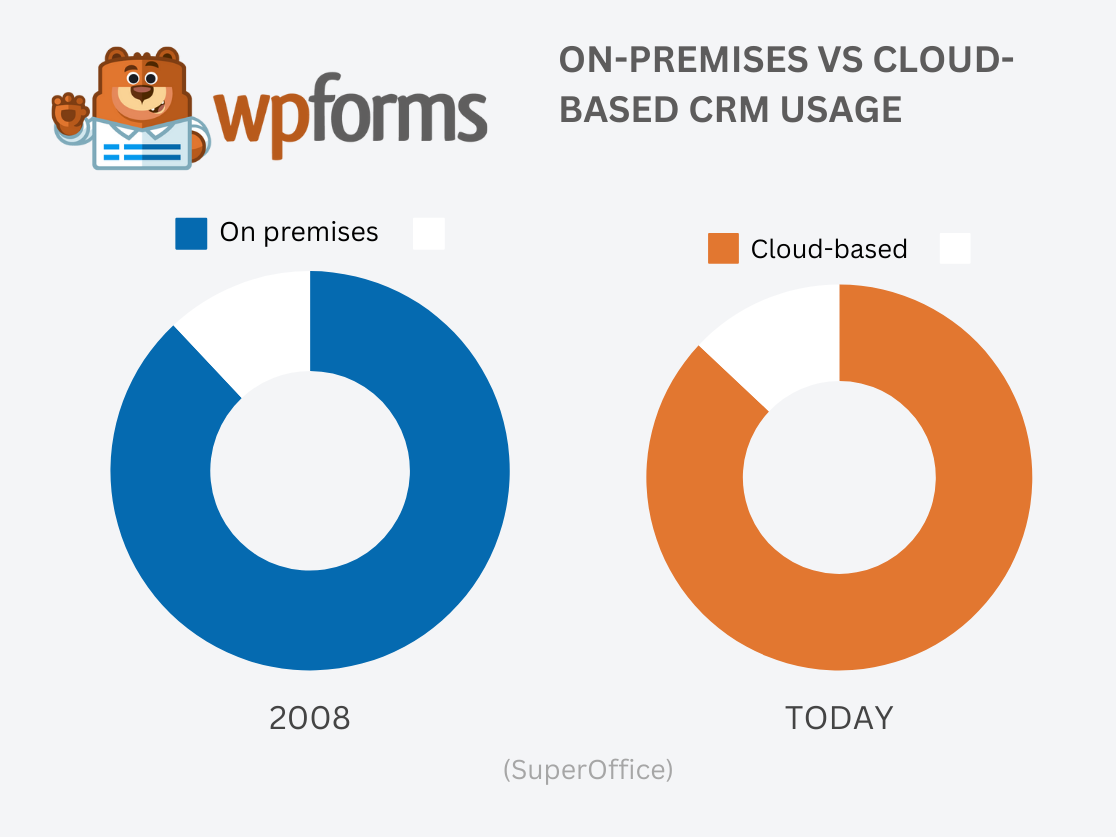
2. Cloud-based CRM solutions made up 50% of the total market share in 2021. (SelectHub)
3. The cloud segment dominated the market in 2022 and accounted for a revenue share of 56.1%. The cloud segment is anticipated to expand at a significant CAGR of 16.1% from 2023 to 2030. (Grand View Research)
4. Approximately 72.9% of CRM spending was on software as a service (SaaS) in 2018. (Gartner)
5. 81% of users access their CRM software from multiple devices, necessitating a cloud solution. (Resco)
What Is the Future of CRM?
All recent statistics and trends strongly suggest a very promising and even explosive future for CRM. With technologies like artificial intelligence (AI), Internet of Things (IoT), and Big Data integrating more deeply with CRM, we can expect exciting transformative changes in the world of CRM within this decade.
Moreover, we’ve seen the resilience of CRM growth as it showed no signs of stopping even during the peak of the COVID pandemic. So there’s every reason to believe that CRM will continue playing a vital role in the growth of small as well as large organizations in the foreseeable future.
Automating Your CRM With WPForms Integrations
As trends suggest, the opportunities for CRM integrations are growing at a quickly accelerating pace. Now, you can even connect your CRM to WPForms to automate processes like creating new contacts in your CRM database directly from forms embedded on your site’s frontend.
WPForms is compatible with some of the most popular CRM software like Salesforce and now HubSpot as well. These WPForms integrations provide great value by helping you improve productivity and eliminate unnecessary administrative tasks from your workflow.
To learn how to connect WPForms with your CRM, see the articles below:
And there you have it! We hope these CRM statistics revealed the wider picture relating to developments around CRM and what we can expect in the years to come.
Next, Improve Productivity with Marketing Automation Software
Combining your CRM system with marketing automation software can help you to save time, automate repetitive tasks, provide better customer service, and nurture leads more effectively.
Take a look at our roundup of the best marketing automation software for small businesses to super-charge your marketing efforts and achieve more in less time.
Create Your WordPress Form Now
Ready to build your form? Get started today with the easiest WordPress form builder plugin. WPForms Pro includes lots of free templates and offers a 14-day money-back guarantee.
If this article helped you out, please follow us on Facebook and Twitter for more free WordPress tutorials and guides.

